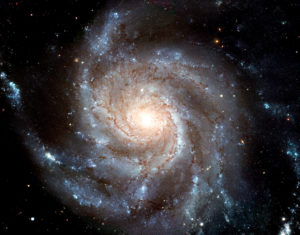INSIDE THE WALLS | Down and Out—Expanding Our Thinking to Survive
 European Space Agency & NASA
European Space Agency & NASA Since it’s possible to get so many scientists on the same page to, say, create a vaccine against a particular strain of the flu, why couldn’t we do the same to find a way to survive the next destructive cycle in Earth’s history?
Climatologists who study the effects of the last ice age place it approximately twenty thousand years ago and tell us the average planetary temperature was around forty-six degrees Fahrenheit. We know that almost all life has been completely eradicated from the planet several times and that it will most likely happen again unless we as a species figure out a way to survive the atomizing event that this author believes occurs about every quarter of a billion years.
When we ponder such ideas as these, then we must wonder at the age of our planet and its sun (about 4.5 billion years), the beginning of our universe some fourteen billion years ago, and the relation of each to the unknown (other universes?) that may potentially collide with, mix with, or cause our universe to contract.
Many if not a majority of scientists with knowledge of astronomical events agree that our sun and its planets are located in the outer extremity of our galaxy. This spiral galaxy takes about 225-250 million years to spin around one time. A very long and deep-thinking pause should be taken so as to really grasp the meaning and true perspective of time and how we currently view or “count” it. By way of calculation, we should be on our nineteenth or twentieth trip around the center black hole of our galaxy. Is it not feasible to imagine that during this journey our solar system passes through a spot in the galaxy (as yet unknown to us) where all matter on Earth is adversely affected? Perhaps along that route there’s a mixture of natural elements and toxins that obliterates life as we know it and rearranges the planet’s structure for the next 225 million years. I can’t be the only one who wants to live long enough to make it through an epoch like this.
Inside these walls, reading about promising new scientific discoveries concerning the sending and receiving of tiny particles of matter called information is awe-inspiring. These nanoparticles are only comprehensible or immediate to most people in the form of a video chat with someone on the other side of the planet. One day you might be in a digital meeting and the next nanosecond you’re in another galaxy watching the light beam coming from Earth showing you your birth.
Great thinkers have illuminated the fact that we know more about outer space than our inner planet. I want to believe that somewhere there exists a suitable zone some yet-unknown number of miles below Earth’s surface. Novels and movies have depicted completely natural subterranean environments that exhibit the elements a little differently but where our species could potentially survive for some thousands or millions of years, after which we’d emerge to the surface and begin the arduous yet exhilarating task of prolonging life individually and collectively.
Surely I’m not the first or only person to imagine this. Credit is duly given to the other freethinking individuals—whether scientists, historians, writers, or laypersons—who’ve realized that within nature there exists everything we need. Matter with energy and space with time. It is basic nature (not supra or supernatural) where we find elements like hydrogen, helium, oxygen, and nitrogen. Break those into the tiniest of particles like atoms and then into the electron, proton, neutron. Before the telescope and the microscope, gods were imagined and used to explain the yet unlearned. Before the locomotive train, time was relative to the local community. What we as a species have accomplished (with or without alien help!) in just the last couple of centuries is simply amazing.
Bars on windows, masks on faces, purchase limits, boundaries with police of all different agency—none of these circumstances can keep a person from using their brain matter and energy to think about future times, future spaces, and the destiny of humankind.
